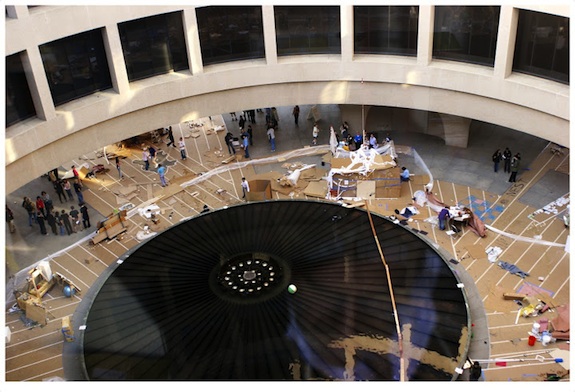Part 2: Who Are the Nominees for the Contemporary Artist Award?
This week’s look at five more names from the prestigious short list and where to see their work
![]()

In 2006, Oliver Herring hosted one his interactive art happenings, called TASK parties, at the Hirshhorn. Photo by Flickr user Oliver Herring
Earlier this month, the American Art Museum announced the 15 artists who have been nominated for the museum’s prestigious Contemporary Artist Award. Big stars in the art world, the artists aren’t household names–yet. As part of our three-part series to help introduce readers to the nominees, we present five more artists nominated for the 2012 prize. (Part III comes next week) Be sure to check out where these artists are currently showing work across the globe.
Oliver Herring: Herring’s career has been marked by constant evolution. The German-born artist began as a painter but made a name for himself in the early 1990s knitting dazzling coats and blankets out of tape and Mylar, according to the New York Times. Made as a tribute to the performance artist Ethyl Eichelberger, these Mylar garments marked Herring’s transition into more dynamic pieces, including stop-motion videos and photo sculptures. Done with a DIY-aesthetic, his work offers a charming look at man’s vulnerability. A single model, for example, is rendered as a tower of discrete photographs. Many of his works are available at the Meulensteen Gallery in New York. Keep an eye out for his interactive, improvisational TASK art events.
Glenn Kaino: This Los Angeles-based artist is all about magic, secrecy and hegemony. Kaino is most interested in probing the invisible resource that is power whether it be the power held by an artist over his audience or a geopolitical institution over its subjects. Everything is fair game, photographs, maps and elaborate, secret safe houses. His intense passion for magic is no coincidence. Kaino is also a trained magician. “The magician’s ethos of secrecy and guarded knowledge becomes a telling metaphor for the perceived esotericism of the art world,” in his work, writes the Los Angeles Times. Kaino was recently selected to represent the United States at Cairo’s International Biennale in December. His sculptural installation for the U.S. Pavilion will be on view from December through February.
Sowon Kwon: A multimedia artist who works with sculpture, video installations and printmaking, Kwon approaches conventional genres including portraiture in unconventional ways. Her video series Human Figure-Average Female, for example, took a pinup calendar and transformed each woman, giving one three heads, another eight arms. Using an ergonomic template common to architectural students, Kwon revealed how, instead of designing for the body, ergonomics has come to define and control the human form. She writes that her art explores what happens when “our bodies are increasingly submitted to and made accessible through technology.” A solo exhibition of her work will run from October through November at Gallery Simon in Seoul, Korea.
Rubén Ortiz-Torres: A big name now, Ortiz-Torres gained fame “by turning his family’s beat-up van into a mobile art gallery,” according to the New York Times. From San Diego, Ortiz-Torres creates everything from video installations to customized cars and machines. NYU’s Steinhardt School of Culture, Education, and Human Development recently put together a down and dirty video retrospective of the artist’s work for its window gallery at Broadway and East 10th Street. “From his early work produced in Mexico City that included the representation of the local punk scene and a post-colonial adaptation of postmodernism to his use of new technologies and materials in California and other experiments in the Central American rain forest, the mean streets of West Belfast and public spaces in New York,” the video tries to capture it all. The project is on view June 9 through September 12, 2012 and is a must-see.
Jaime Permuth: The Guatemalan photographer has a gift for making the unseen, visible. His series Manhattan Mincha Map began after the photographer discovered a listing of all the places Jewish men in New York can gather to recite the afternoon prayer with the required quorum of ten people. He writes that many were synagogues but most were workplaces. The men in his photographs are shown praying in the basements of electronics stores, standing among towers of boxes. Chronicling the hidden markers of community, his photography is often exhibited around New York City. View his photographs here.
Still to come: Will Ryman, Ryan Trecartin, Mark Tribe, Mary Simpson and Sara VanDerBeek.
/https://tf-cmsv2-smithsonianmag-media.s3.amazonaws.com/accounts/headshot/Leah-Binkovitz-240.jpg)
/https://tf-cmsv2-smithsonianmag-media.s3.amazonaws.com/accounts/headshot/Leah-Binkovitz-240.jpg)